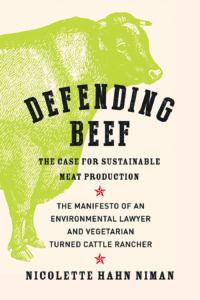BOOK REVIEW: Defending Beef: The Case for Sustainable Meat Production
In Defending Beef, author Nicolette Hahn Niman takes on no easy task: as the title suggests, this vegetarian cattle rancher seeks to exonerate beef from the many ills for which it’s blamed, both from ecological and nutritional perspectives. She anticipates every argument, discussing everything from the role cattle play in water contamination, soil health, and carbon sequestration, to the 20th-Century uptick in chronic diseases often blamed on excessive meat consumption. Far from the contemporary knee-jerk tendency to draw black-and-white conclusions in the face of complex problems, Niman distinguishes between resource-intensive, environmentally destructive factory farming and other grass-based ranching techniques that, as she shows, have great potential for environmental benefit.
The author presents her case in two sections, Cattle and Beef. In the first, she discredits popular ideas about the environmental impact of cattle ranching, including a well-known and oft-cited UN report blaming meat production for 18% of all greenhouse gas emissions. She advocates unequivocally for grass-based cattle ranching, presenting it as a category quite distinct from feedlot farming. Her perspective is grounded in grassland ecology and the agri-political issues surrounding land usage. It can be summed up in a few wordy sentences: grasslands are important, biodiverse, underappreciated carbon sinks and soil-conserving ecosystems that evolved in symbiosis with ruminant herbivores. Without grazing herbivores, grasslands suffer a loss of biodiversity and slowly turn into forests. Or, put more simply: We need grass. Grass needs cows.
Returning cropland to the prairie that preceded it and grazing cattle or other ruminant herbivores allows for the environmental benefits of a grassland ecosystem (biodiversity, carbon sequestration, erosion prevention, water filtration – the list is impressive) while also allowing nutrition to be harvested from grass in the form of beef. Removing beef from our diets would result in more grasslands being converted into cropland at the cost of thousands of tons of topsoil yearly and irretrievable plant and animal habitats.
In her second section, Niman proposes that the chronic diseases popularly linked with excessive meat consumption are more likely a result of increased sugar consumption, citing the research of various nutrition experts as well as statistical trends in the American diet over the past century.
The premise of Defending Beef is certainly ambitious, and the resulting text is informative and, overall, well-researched. In covering such a broad range of arguments, however, Niman’s manifesto loses some intensity. It comes across rather like an introductory survey course, spending too few words on each topic. This book could have been much longer, or divided into several separate books, each addressing a different aspect of the problem. Still, Niman’s writing is simple and straightforward, and as a survey course it succeeds in introducing the concepts necessary to talk about cattle as part of a responsible food system.
Most compellingly, Niman implores us to consider the impact of our food systems in a manner more nuanced than we usually allow, refusing to paint with the broad strokes of “good” and “bad”. Instead, she presents both advocacy and critique of her beef industry and picks apart common ideas about agriculture and nutrition that don’t hold up to scrutiny. This book is an excellent read for anyone, vegan or omnivore, who is concerned about the footprint of their dietary and agricultural decisions.


